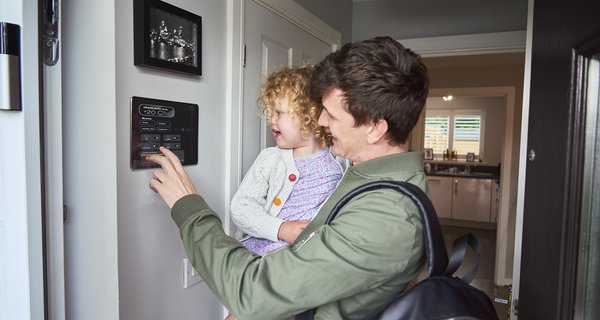Landlords’ experiences of energy efficiency measures
After asking our interviewees about their experience as landlords, we delved into the topic of energy efficiency upgrades. Our conversations suggested that while most landlords we spoke to had some experience with fitting energy efficiency measures, such as insulation, they were more reticent with installing other technologies, such as solar panels in their rentals, even if they had already installed them in their own homes. Less professionalised interviewees also showed low levels of awareness about funding, and were more likely to outsource thinking about energy efficiency to letting agents.
EPCs as a tool for understanding energy efficiency
When asked about what measures they had taken to understand the carbon emissions generated by their rental properties, our interviewees’ first response was often to mention their property’s EPC, even if they could not always remember their property’s exact rating during our interviews.
EPCs were used as a guide to upgrade one’s property: ‘EPCs are a good sort of thing to look at and get an idea of where you need to focus on.’ (Valerie). Interviewees generally showed awareness of regulations, and several reported having gone above the current threshold of E, even if they could not always recall their exact EPC. For example, Amy told us her home exceeded current regulations: ‘They're all D or above and the majority are C, but, like, you know I've got a couple of old terraces, and I think I don't know how they'd get [more energy efficient]’. Several interviewees felt that they had already taken the measures they could, within their budget, and were daunted by the cost and complexity of further investments to reach an EPC C.
In Scotland, where MEES regulations have not yet been introduced for the private rental sector, bringing homes to an EPC C may represent a bigger jump – but our interviewee, Rhoda, also reported having gone above and beyond regulatory obligations with her own properties: ‘Obviously, I'm aware that the EPC ratings are going to become mandatory, and it's gonna have to be a C, although I'm not sure when that's going to be in Scotland. (...) But anyway, I've done it already, so it doesn't matter.’
What kind of energy efficiency improvements have landlords made to their rental properties?
Most of our interviewees had implemented some energy efficiency measures in their properties, often motivated by compliance. Rather than reducing carbon emissions, energy efficiency measures were primarily motivated by a desire to futureproof the property, offer a decent housing standard, keep bills lower, attract wealthier or longer-term tenants, and maximise return on investment while also increasing the property’s value. A lot of the landlords we spoke to expressed a desire to improve their property’s longevity with good quality materials in order to not have to go through that process again, balancing costs and quality: ‘I wanted to do it once, and then not have to do it for years.’ (Viola).
Insulation was the most frequently mentioned form of energy efficiency improvement adopted by participants for their rental properties, followed by a new boiler, double glazing, new doors and windows and thermostats. One landlord (Hussein) had also fitted his property with LED lighting. Notably, landlords who mentioned having strong environmental motivations (scoring three or above in our questionnaire) were not necessarily the ones who had done the most upgrades to their properties, and highly professionalised participants like Ted and Hussein reported having done extensive works to their property to bring them to a high standard, although only Ted expressed a high degree of willingness to invest in his property to make it greener.
Types of measures installed by interviewees
Scotland-based Rhoda stood out as a particularly eco-conscious landlord. Rhoda had equipped three of her rental properties with solar panels that utilised the Feed-in-Tariff (FiT). This arrangement meant that Rhoda allowed her tenants to directly consume electricity from the solar panels, while she profited from any excess being sold back to the grid. Such funds, while not specifically targeted at landlords, can counter the split incentive effect by incentivising energy efficiency and decarbonisation measures. While FiT is now closed to new entrants, new installations can still benefit from the Smart Export Guarantee (SEG) from licensed providers. She also reported using her own home as a test bed before making additions to her tenants’ homes, and helping them maximise the efficiency of their solar technologies: ‘I have 3 tenants with solar panels, and I have to check in every 3 months to get meter reading, so I'll check in to see, can I get a reading? And you know, is everything okay? And give a bit of advice on how to make the most of it’. This was also motivated by a desire to help her tenants keep their bills low. Rhoda was the only landlord interviewed to have fitted this technology in her rental, and went above and beyond in attempting to improve her tenants’ quality of life (including paying towards tenants’ holidays when she needed to do extensive works to the property).
One hypothesis we formed at the start of the project was that landlords installing ‘green’ technologies in their own homes would be more likely to do so in their rental properties, but we did not necessarily find this to be the case across our interviewees. Instead, landlords we spoke to seemed to separate the application of their environmental beliefs to their own properties from their approach to renovating their rentals, where cost was of greater concern. Of the four interviewees who either told us in the survey or interview that they had equipped their personal homes or camper van with batteries and solar panels, only one had done the same to their rental properties. For example, Valerie explained that her environmentally conscious partner would ‘feel more comfortable, paying more and knowing that it was more environmentally friendly’ for measures to their rental properties and that they had fitted solar panels into their own property. She told us they might consider doing the same in their rental properties, provided they could access tax relief schemes or other incentives: ‘We would definitely look into solar panels. If it was some kind of tax [of that] thing that you know landlords could do, then we probably could look into doing something like that.’ However, when discussing equipping her rental with solar panels, she felt the upfront cost was too much for her to install them: ‘Solar panels may help, but then it would probably cost me thousands to put solar panels on their roof. Well, you know, what do I do instead? Just give them thousands towards a heating bill? I don't know. I mean, it's just… where do you stop?’. Rhoda was the only interviewee to mention FiT, and none mentioned SEG.
Approaches to energy efficiency measures
Among our interviewees, landlords who identified as professionals were more likely to take a strategic approach to retrofitting their rental, either conducting work after purchasing their property or when it was empty. Two landlords we spoke to (Matthew and Ted) had used the services of energy surveyors who provided assessments of energy efficiency measures and helped them renovate their properties in order to plan ahead. Ted hired an assessor upon purchase to devise a strategy to raise his property’s EPC and invested £10,000 to renovate a house he wanted to turn into an HMO, with an aim to ‘future-proof it’. He explained how he had prioritised measures: ‘We ran through what the various measures would do in terms of raising the EPC and where I’d get the biggest bang for my buck and the real big one was insulating the walls internally.’ Others like Rhoda or Amy would prioritise purchasing cheaper properties to renovate and rent them out. Amy, for example, told us: ‘We've bought a couple of repossessions or like they've needed like major work. So we tend to do it all before the move-in like we'll renovate a property’.
By contrast, landlords in our group who did not manage their properties themselves mostly renovated their properties on a more reactive basis. For example, Viola, who handed over all upgrades to her letting agent, relied on her agency to warn her of any works needing to be done: ‘We don't really change anything unless it's like really broken or needs changing.’
Balancing costs and income
Cost was the top concern of the landlords we surveyed when it came to fitting homes with energy efficiency upgrades. For participants with a smaller portfolio, the need to increase the efficiency of the property had to be balanced with keeping costs low, and this could outweigh stated environmental preferences. For example, Lauren reported high levels of environmental motivation but expressed her reticence at the upfront cost of low-carbon technologies: ‘even with my own home that I live in, you know, ideally, it would be great to have solar panels and everything, ticking all the boxes for carbon emissions and climate change and everything. But it's just so expensive.’
The period required to secure a return on their investment was another concern. For example, Matthew highlighted that the payback period for technologies like heat pumps and solar panels was too long to be attractive, worrying about the technologies’ lifespan compared to their payback period: ‘It's taking you a long time to actually get that money back. [...] Is that ground source heat pump still going to be going in 10 years? Are the solar panels on your roof still going to be doing what they're meant to be doing in 10 years?’
In our cohort, it transpired that, for the more professionalised landlords willing to upgrade their properties, energy efficiency upgrades are part of a suite of investments to optimise the quality and longevity of their rental and guarantee a good return on investment. This dynamic was most visible in the case of Ted, who explained he had ‘looked at energy saving initiatives for the other two HMOs’ but that he was not impressed by the return on investment as he would be ‘looking at a 10-year payback.’
The ability to have a longer outlook set Ted apart from smaller portfolio participants who approached their rental income on a year-by-year basis, like Valerie: ‘But you've only got a certain amount of money that you can spend on these sorts of things, because otherwise… It's not worth doing; it becomes negligible. [...] if you, you know, you’re perhaps getting a thousand pounds a month, and your mortgage is 350 pounds, and then you've… all of a sudden, you've put in a heat source pump [sic] and it's cost you thousands.’
Funding and finance
The landlords we spoke to showed mixed levels of awareness around grants and funding they could access to support energy efficiency upgrades. Levels of awareness and understanding tended to be lower in interviewees who had outsourced the management of their property to a letting agent, and were more likely to rely on them to let them know about opportunities.
Several of the landlords we surveyed were aware of means-tested funding, and having a tenant on benefits had encouraged several interviewees to look into whether they could use means-tested funding in the past. Rhoda and Matthew, who had successfully used government funding due to having tenants on benefits, showed the highest levels of awareness and a proactive approach to funding, with Rhoda, in particular, showing an open-minded approach to letting her tenants request energy efficiency upgrades in her rental properties. However, most landlords we interviewed, even when more professionalised, expressed levels of uncertainty around the purpose and eligibility criteria of funding schemes, sometimes assuming from the outset that they would not be eligible themselves due to being landlords. For example, some interviewees were either confused by, or assumed that landlords would not be eligible for, the Boiler Upgrade Scheme (BUS), as was the case with Mary, who seemed to confuse the BUS with a boiler scrappage scheme: ‘If I had an old boiler in my house, they would change it free, because it's my property. But if you rent out a house, those schemes don't… aren't extended to rental properties’.
We also encountered some levels of scepticism from landlords who had previously been frustrated in their attempts to find funding, including Ted and Amy. In addition to this, interviewees such as Dean and Rhoda were critical of scheme guarantees following negative experiences. For example, Dean described how he had commissioned insulation and solar thermal (‘hot water solar’), via the previously available funding from the Green Homes Grant, but felt that ‘in practice we've been let down by the various grant schemes’. A shortage in materials during the pandemic led him to miss the deadline for the work’s completion, causing the grant to be withdrawn. The withdrawal of the grant resulted in Dean having to reduce the extent of the work (which included other home renovations). Rhoda mentioned a negative experience with one of her properties, which had been fitted with non-breathable insulation under the Warmer Homes Scotland scheme, which turned out to be unsuitable for her property, only to find no guarantee or support with remediation was available when her tenant moved on and the company that had delivered the works closed down.
How do landlords consider tenants when doing energy efficiency modifications to their properties?
The majority of the landlords we interviewed did not see energy efficiency improvements as direct selling points from a tenant’s perspective, but rather part of a baseline offer to retain tenants, with Rhoda noting that, even if she advertised improvements to the house and had to include the property’s EPC in adverts, prospective tenants were usually more interested in the cost of bills: ‘other than, what are the bills like in this house or this flat [...]. That's about the only question I get asked.’ Similarly, William thought a well-insulated house was a baseline expectation for his wealthier tenants, and had improved his properties accordingly: ‘Tenants would expect as much insulation as possible. We try and position ourselves in the upper quartile, so those sorts of things would be standard, really, and we can command a higher rent than we could if the place wasn't modernised.’
One question we considered was whether landlords would be more likely to install low-carbon technology upgrades if prompted to do so by tenants. Some landlords we surveyed mentioned being open to having tenants contribute to the upfront cost of energy efficiency modifications, as was the case with Lauren, when asked how she would reply to a hypothetical request from tenants to upgrade her property to lower its carbon footprint: ‘Maybe if they offered to contribute or pay half or something.’ Not all interviewees, however, were comfortable with the option of asking tenants to contribute to energy efficiency upgrades. For example, Amy felt that this solution ‘leaves the door wide open then for issues when you're trying to sell, because what they're saying is they've invested money in [the] property’, suggesting that tenants’ financial contributions might create uncertainty over the ownership of the asset or retrofit measure.
Louis, who had experienced conflict with his tenant over rent increases, explained that disagreement over upgrades or expecting tenants to contribute towards their cost could be a source of tension, stating: ‘I think if any work needed doing or anything needed upgrading, she would be quite awkward about [it] (...) and generally if we need to do a rental increase to be able to make those improvements. If she doesn't agree to them, then that becomes obviously a much more difficult situation.’
Where tenants’ energy use was concerned, interviewees had different attitudes depending on whether they knew their tenants’ energy use, with attitudes ranging from indifference to a desire to keep bills low to appeal to tenants to a more controlling attitude. Participants who were HMO landlords and packaged bills as part of the rent could go so far as to influence or control their tenants’ energy consumption remotely, in the case of Ted. Ted argued this was a means of keeping bills low as energy savings were an integral part of his payback strategy on retrofit, as he ‘forecast the payback in terms of lower heating bills’. As a result, he explained, ‘I remotely control all the heating. It's really important that we do that, otherwise the tenants will just have the central heating on’. Keeping an eye on tenants’ bills was a shared theme among HMO landlords we spoke to: Mary, who rented out an HMO property, told us: ‘I tried to educate them many times on how to use less energy’. She had therefore established a billing system with her tenants: ‘in the summertime, I pay X amount for gas and electric, and if they use more, they pay. It's divided between the 5 tenants, and in the winter I pay more because they need more, and if they use above and beyond that, they pay.’






